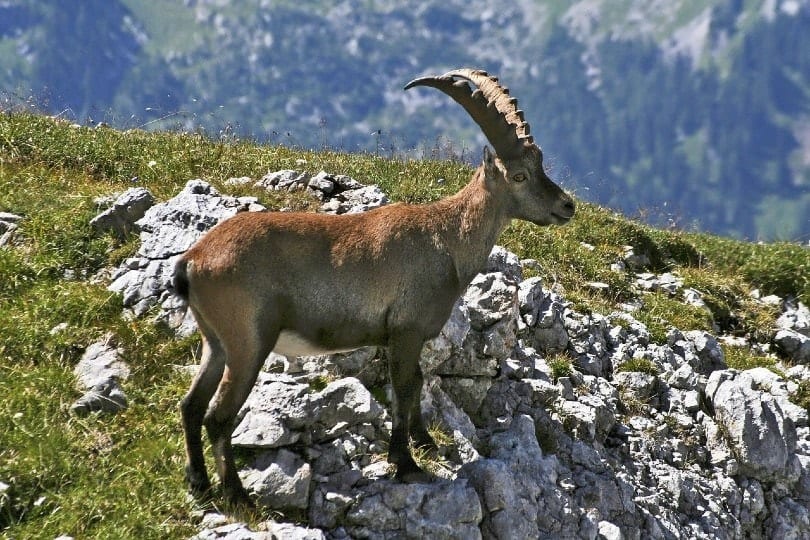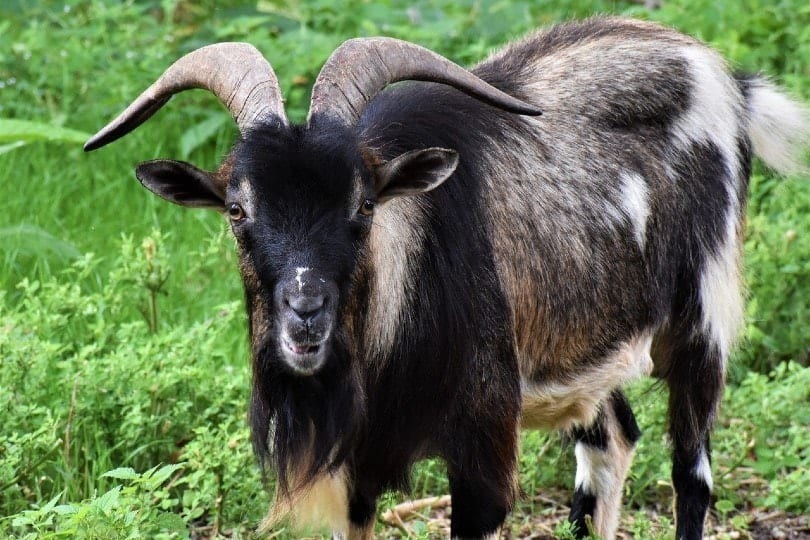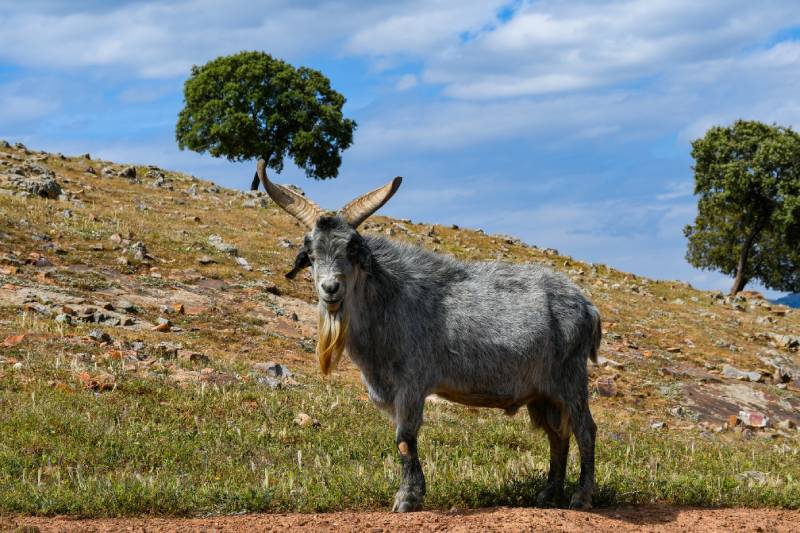The Spanish goat breed is among the most antiquated goat species globally. Although it is traditionally known as a farm animal, it has become a perennial favorite in households and petting zoos due to its versatility and the ability to form a close relationship with its parents.
Yes, the Spanish goat is versatile – it brings joy to owners as a companion, you can enjoy its milk, and like other goats, it can be a good exercise program for you and your kids. But before you resort to taking a Spanish goat home, how much do you know about this breed?

Quick Facts About the Spanish Goat

| Species Name: | Capra Aegagrus Hircus |
| Family: | Bovidae |
| Care Level: | Less needy, Independent |
| Climate: | Tolerate severe temperatures |
| Temperament: | Active, curious, but docile when socialized |
| Color Form: | White, brown, gray, black |
| Lifespan: | 6 to 7 years |
| Size: | Medium-large, weigh between 50-200 pounds |
| Diet: | Alfalfa hay, herbs, leaves, shrubs, weeds, require fewer feeds, and less water |
| Minimum Enclosure: | More than 4 feet high, with a roof |
Spanish Goat Breed Overview
Spanish goats are among the ancient goat species and have a long regional history extending to various parts of America. They are known to thrive in extreme climates and are parasite-resistant – probably why they have many names; brush or scrub goats, wood goat, hill goat, and briar goats.
Spanish explorers brought this goat breed to America from Spain via Mexico in the 1500s. The explorers would use these goats as a ready source of meat and milk throughout their mission before stopping by the Caribbean Islands, where the goats “seeded” to Mexico and the U.S.
The Spanish goat breed has been subject to selection pressure and was mainly used for crossbreeding with other native goat breeds thanks to their hardy traits, great mothering instincts, and excellent litter size.
This widespread crossbreeding adds to the Spanish goat’s genetic and historical importance in America. Unfortunately, the breeders concentrated more on selection than maintaining the pure breed itself.
Today, the Spanish goat breed survives because of some American breeders who’ve been responsible for its improvement, recognition, and bloodline preservation. These improved Spanish goats are now more muscular, meatier, and produce more milk than the regular Spanish goat breed.
Since they are browsers, these goats are also famous for bush-clearing, shaping the landscape, and improving pasture for grazers. Although it is hard to milk this breed consistently, they produce unmatched year-round high-fat milk. More people have learned to appreciate the improved Spanish goat, and they are unwilling to crossbreed this threatened goat species.
How Much Do Spanish Goat Breed Cost?
Spanish goat breeds are usually affordable and are mainly used for commercial purposes, especially for meat production. They averagely cost $300 to $350, with the female being more expensive than the male.
The good thing is that these species require little medical intervention and infrequent deworming because they are parasite-resistant. They also tolerate harsh climatic conditions and survive on low-quality pasture, meaning you don’t have to spend too much on quality feeds.
Some owners even claim they never have to trim their goats’ hooves. For this reason, the Spanish goat breed spares its owner’s expenses such as grooming and maintenance.

Typical Behavior & Temperament
Spanish goats are active species and are flighty, athletic, and agile jumpers. For this reason, they make great pets for energetic parents. They do not identify as docile or calm and are not as tamed as other goat breeds, meaning they can be hard to handle.
The goats are naturally resourceful and can make catching them to milk or maintain a struggle. And just like other goats, the Spanish breed thrives in herds and are happier when paired. However, they are independent creatures and may not socialize or require human attention that much.
Appearance & Varieties

Looks
The Spanish goats are beautiful goat species with a straight and concave face. This breed is characterized as a landrace and has varying appearances because of excessive crossbreeding.
Both female and male goats have large and long horns that seem to twist outwards. The ears are equally distinct, large, long, and lay horizontally and forward, close to the head.
They have moderate sizes and growth rates. The goats weigh 100-150 pounds and have small udders and teats. On the other hand, the bucks weigh 200-250 pounds.
These animals are hefty but compact and have an average height of 17 inches to 25 inches. Although they have less muscle than other breeds, they are hardy, can tolerate harsh climatic conditions.
Coat
A Spanish goat’s coat can have short or long hair and might grow fringes on their lower bodies and thighs. Some even heavy desirable coats owners can harvest for mohair production.
Color
This breed is not limited to specific color shades. And all their dazzling colors and patterns on their hair are acceptable.

How to Take Care of the Spanish Goat Breed
Spanish goats make an excellent addition to a homestead if you take good care of them. The good thing is, they are pretty easy to take care of compared to other breeds. Give them shelter, water, and a little concern, and they are happy. Here’s how to achieve that.
Enclosure

Although they may be all-weather, Spanish goats require fencing against snow, rain, extreme heat, and wind, just like other species. However, they don’t require fancy housing because they are resourceful creatures and need ample space to run and exercise. Therefore, your fence should be strong to withstand the wear and tear the goats may subject it.
The enclosure should be 4 feet high, maybe 5 feet minimum because these species can jump that high. It should also be tight enough to prevent the animals from pushing it down.
These goats can do anything to get out of a small enclosure, especially if they are attracted to forage on the other side. For this reason, fix the fence deep in the ground and place the posts not more than 8 feet apart to keep them in as much as possible.
You have various materials to choose from when making your fence, and they include; woven wire, cattle panels, or welded wire. You can also run a strand of electric wire along the enclosure to prevent them from leaning, bending, jumping over the fence. But then, the housing must be effective in keeping the goat in and the predators out.
Bedding
Your animal’s bedding should offer it comfort when it walks or lies down and should be able absorbs urine and feces. You can use wheat straws or wood shavings because they are less dusty and much more comfortable than wood pellets.
Temperature
The Spanish goat breed can withstand hot temperatures. However, you should set its sheds’ roof a bit low in the ground so that they can collect body heat to keep them warm during the cold season.
Lighting
These species prefer well-lit areas. Therefore, the pens should have windows and openings to let in enough light and for ventilation.
Does Spanish Goat Breed Get Along with Other Pets?
Spanish goats are more social when in herds and may need at least one other goat for company. Therefore, you can have two or more goats in one pen.
This breed can also coexist and get along with other naturally friendly and accepting household pets like cats. However, be careful when pairing your goat with other animals with predatory instincts such as dogs. A hunting dog may see a Spanish goat as prey.
On the other hand, Spanish goats become aggressive and can attack when provoked. Therefore, remember to monitor your pets’ interactions if you intend to keep your goat with other new animals. Only leave them together if you are sure that they are trouble-free.

What to Feed Your Spanish Goat Breed
Although these goats can survive on low-quality pasture, you should strive to provide them enough feeds and give them access to enough fresh and clean water.
Lactating Spanish goats do not require as much water because they produce lesser milk than other goat breeds. But they do need enough feeds and minerals for the newborns. However, avoid overfeeding pregnant Spanish goats to prevent pregnancy toxemia.
Spanish goats are browsers and would gladly nibble on shrubs, tree barks, weeds, and herbs. They can also climb trees to access leaves. Giving them freedom will allow them to look for pasture and enable them to exercise in the process.
However, if you can’t access enough grazing space, provide high-quality alfalfa hay for healthy animals and quality milk. This hay is rich in calcium that goats require, especially when pregnant or lactating.
If the hay is too costly, you can supplement the feeds with minerals. You can use mineral supplements meant for cows because both cows and goats require copper. Sheep’s supplements will intoxicate your goats.
Or, provide fruits and veggie refuse from your kitchen spice up their diet. You can socialize with your Spanish goat by hand-feeding veggies and grains.

Keeping Your Spanish Goat Breed Healthy
Although Spanish goats can tolerate parasites, they are not immune to diseases, especially in a dirty pen. Ensure you clean its housing every day and change its bedding at least once a week.
It would be best if you also channel out its urine and feces. Wet beddings provide a breeding ground for parasites that can infest your goat.
It is equally vital to engage a veterinarian for a detailed health schedule such as a regular deworming routine and vaccination. Your pet goat requires scheduled vaccinations against diseases like Clostridium Perfringens Types C and D and tetanus (CD&T).
Also, groom your pet occasionally to prevent foot root – a bacterial infection that affects the space between the goat’s two toes. Take care of your goat’s nutritional needs by providing them enough forages and supplementing their feeds with 16%-20% proteins and vital minerals to keep them healthy. As much as Spanish goats are herders, avoid overstocking their enclosures to prevent health issues that arise from infectious diseases.
Breeding
Spanish goats are polyestrous species and can breed in all seasons except the coldest time of the year. Interestingly, they can start heating as early as five months.
However, goat owners should wait until it is at least eight months or weighs 80 pounds before allowing it to mate. It is vital to prevent birth complications.
Spanish goats usually throw signs such as mucous discharge, swollen rear end, unusually loud yelling or bleating, and increased interest in bucks when they are on heat. To allow mating, you should expose the buck to the doe for 4-6 weeks. Ensure that you allow them as many mating chances as possible to prevent tasteless milk.
The goats have a gestation period of 155 days after breeding. The good thing about this breed is that they are incredible at kidding. They give birth to twins, triplets, or more. These female Spanish goat breeds give birth without assistance and have incredible mothering traits to their kids.

Are Spanish Goats for You?
Nothing is more satisfying than successfully rearing productive goats in a homestead, a small farm, or in hot and harsh terrains. Well, you can rear Spanish goat breeds from anywhere in the world without struggling because they are the most tolerant and manageable breeds you can get.
It is a win for you because you enjoy multiple kids yearly, high-quality milk and the best meat without spending a lot on feeds, and luxurious housing. However, ensure that you can meet this breed’s needs before committing to getting it for a pet.
You should also check for any zoning regulations within your location to confirm if you can keep a pet goat. Providing your Spanish goat adequate housing, vaccinations, and necessary feeds can allow you to live with it from 6 to 7 years, or even 10!
Featured Image Credit: Nik Bruining, Shutterstock
